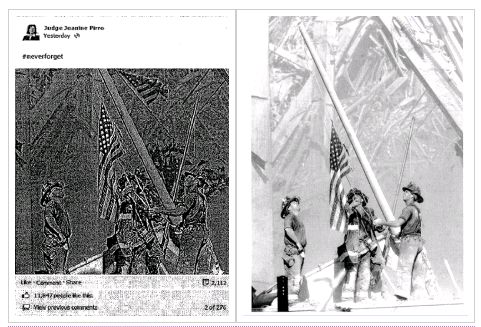In the coming days, a trial is set to begin in the Southern District of New York in the case of North Jersey Media Group Inc. v. Jeanine Pirro. The case raises interesting questions about "fair use" in copyright and the use of photos as part of a social media conversation. The controversy began when a Fox News Network ("Fox") show, "Justice with Judge Jeanine," cropped a photo, "Raising the Flag at Ground Zero," by Thomas Franklin, then combined and juxtaposed it with a picture of soldiers at Iwo Jima taken by Joe Rosenthal, and posted it on Facebook with the hashtag "never forget."

The above images, taken from the filed complaint, have been sized for purposes of comparison. The photo on the left was posted by the Fox News Network show, "Justice with Judge Jeanine," and the photo on the right is "Raising the Flag at Ground Zero," for which North Jersey Media Group brought suit.
North Jersey Media Group ("NJMG"), claiming ownership of the photo, sued the show and Fox for use of the photo. Fox argued that the photo's use was a "fair use" because it was part of a conversation about Ground Zero and 9/11 and therefore "transformative." But the district court judge disagreed, and denied Fox's motion for summary judgment in February 2015. The decision focused on the fourth factor in the four-part fair use analysis, whether the use would harm the market for the photo, stating that market is the "most important" factor. It discussed the licensing revenue NJMG had received from the photo and the potential harm to that revenue if the use were allowed. It did not consider the "purpose" of the use as much as the small degree to which Fox had altered the photo.
Fox appealed that decision, and the case thereafter looked as if it were going to settle. Instead, it now appears it will be up to a jury to decide whether the Fox use qualifies as "fair."
Section 107 of the Copyright Act lays out the four-part test for analyzing whether a work is a "fair use": (1) the purpose and character of the use; (2) the nature of the use; (3) the amount and substantiality of the portion of the use; and (4) the effect of the use on the potential market for the work. The standard for what is "transformative," considered part of the first factor, comes from a parody case before the Supreme Court, Campbell v. Acuff Rose. It requires that a new work alter the original with "new expression, meaning, or message." In 2013 in Cariou v. Prince, the Second Circuit clarified that the new work need not be a critique on the original message, as was the case in Campbell, in order to have the requisite "new expression, meaning, or message."
Fox's argument on "transformative" use appears to be to some degree about the different context for the work by putting it on a social media feed where there is comment and sharing. To date, decisions in the Second Circuit have stopped short of saying a change of medium to social media alone is enough to "transform" a work. However, there is an added element of commentary when Fox says that the use on the Judge Jeanine page made it part of a conversation about 9/11. In sum and substance, Fox has argued that the original use was for news reporting, whereas Fox's use is part of a conversation looking back on history. "Commentary" is not part of the four-part test, but is an example provided in the Copyright Act of a purpose for which a use is fair. Specifically, before laying out the four-part test, section 107 of the Copyright Act permits what would otherwise constitute an infringing use if the use is made for criticism, comment, news reporting, teaching, or scholarship and research. So perhaps there is also some question here whether the conversation for which the 9/11 photo is used is one of public interest, and part of the types of uses the Copyright Act considers fair.
NJMG will undoubtedly stress the arguments made in the district court decision and argue that the placement of a photo on social media cannot by definition put it outside the realm of copyright protection and that doing so would defeat the incentive for photographers and photojournalists to work and make a livelihood. Indeed, the fact that the parties are both media outlets may help these arguments.
The case raises broad questions about the use of photos on social media, which are regularly shared and discussed without attribution or license by users. It also raises questions about the use of images as part of a conversation and not as a "use" of the work in the same sense as its original use. It can be powerful and impactful to speak through images, certainly. But when, exactly, are you giving that image a "new expression, meaning, or message" such that it is "transformative" and, further, such that it is "fair"?
The content of this article is intended to provide a general guide to the subject matter. Specialist advice should be sought about your specific circumstances.
